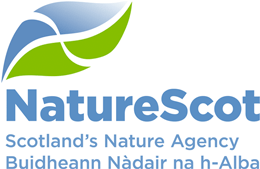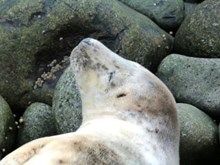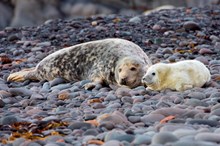17 September, 2015
Seals in the spotlight on the Isle of May
Grey seals will be in the spotlight on the Isle of May’s over the weekend of 26 and 27 of September, with a SNH event to give people the chance to see seals basking on the rocks and to learn more about their secret lives.
Visitors will hopefully be able to view the first pups of the season.
There will be telescopes set up and staff from the Sea Mammal Research Unit based at St Andrews on hand to answer questions about the studies carried out on seals on the Isle of May. There will also be seal-themed crafts and stories for the younger visitors to enjoy.
David Steel, SNH Reserve Manager, said, "Visitors are usually drawn to the May to see the puffins, razorbills and all the other seabirds, but it’s a terrific place to watch seals too. They’re such curious and fascinating creatures – it’s certainly worth the trip out to see them. We’ll also have an expert on hand to tell people more about the seals and all the seal research that happens on the May.”
Up to 100 grey seals can be seen around the island at any time of year, but their numbers increase in autumn and winter when up to 4,000 seals haul themselves onto the rocky shores of the island to have their pups and mate. This makes the Isle of May the fifth largest breeding colony of grey seals in the UK and the largest on the east coast of Scotland. Around 2,000 pups are born on the May every year.
Atlantic grey seals are the third rarest seal in the world; Britain holds almost 40% of their world population, and 90% of these breed in Scotland.
The seal weekend is free, but you must take a boat trip to reach the island. Sailings are on the privately-run May Princess or Osprey of Anstruther from the Anstruther Harbour or through the Scottish Seabird Centre in North Berwick.
- Anstruther - for tickets and details, see www.isleofmayferry.com (May Princess) or www.isleofmayboattrips.co.uk (RIB Osprey).
- North Berwick - For tickets and details, book online on the Scottish Seabird Centre website at www.seabird.org or call 01620 890 202.
Known locally as 'The May', this small island sits on the edge of the Firth of Forth. The island's importance for seabirds has drawn scientists to its shores for many years and the May is home to the oldest continuously running bird observatory in the UK. The May is also a regular haunt for grey seals, often seen lounging on the shoreline rocks. This island is a historical gem and it's been a place of pilgrimage for centuries with an early island monastery. The May was also the site of Scotland's very first lighthouse, built in 1636, while the current, castle-like lighthouse was designed by the engineer Robert Stevenson.
ENDS
The Isle of May is one of over 50 national nature reserves in Scotland. These are special places that look after some of the best of Scotland’s nature on behalf of everyone who lives or visits Scotland, and they provide unique opportunities to visit, enjoy and learn more about Scotland’s nature. For more information, see www.nnr-scotland.org.uk
Contact information
- Name
- SNH Media
- snhmedia@snh.gov.uk
NatureScot is Scotland's nature agency. We work to enhance our natural environment in Scotland and inspire everyone to care more about it. Our priority is a nature-rich future for Scotland and an effective response to the climate emergency. For more information, visit our website at www.nature.scot or follow us on X at https://x.com/NatureScot
’S e NatureScot buidheann nàdair na h-Alba. Bidh sinn a’ neartachadh àrainneachd na h-Alba agus a’ brosnachadh dhaoine gu barrachd suim a chur ann an nàdar. Tha e mar phrìomhachas againn gum bi nàdar na h-Alba beairteach agus gun dèilig sinn gu h-èifeachdach le èiginn na gnàth-shìde. Tha an tuilleadh fiosrachaidh aig www.nature.scot no air X aig https://x.com/NatureScot


